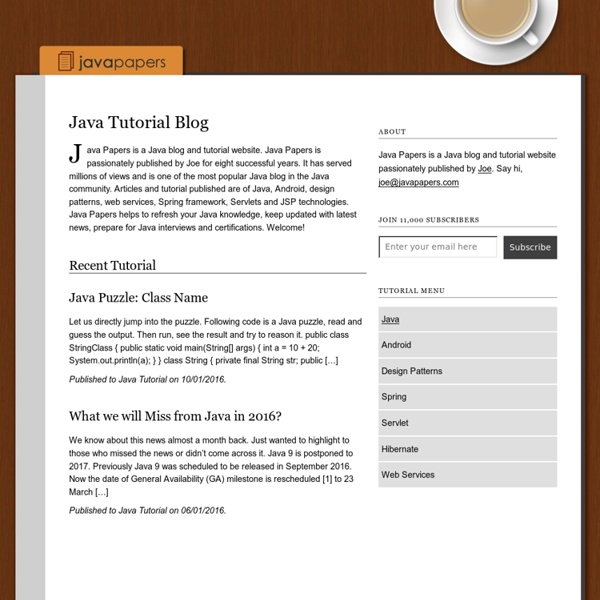



MyBatis Examples and Tutorials Coreservlets.com: Java, JSF 2.0, Ajax, jQuery, Spring, Hibernate, REST, Hadoop, and GWT Training, Tutorials, Consulting, Books, & Resources Differentiate JVM JRE JDK JIT Java Virtual Machine (JVM) is an abstract computing machine. Java Runtime Environment (JRE) is an implementation of the JVM. Java Development Kit (JDK) contains JRE along with various development tools like Java libraries, Java source compilers, Java debuggers, bundling and deployment tools. JVM becomes an instance of JRE at runtime of a java program. Diagram to show the relations between JVM JRE JDK JVM Internals Like a real computing machine, JVM has an instruction set and manipulates various memory areas at run time. A Java virtual machine instruction consists of an opcode specifying the operation to be performed, followed by zero or more operands embodying values to be operated upon. Sun’s JVM Sun’s implementations of the Java virtual machine (JVM) is itself called as JRE. JVM for other languages A JVM can also be used to implement programming languages other than Java. Just-in-time Compiler (JIT)
Java Blog Java le soir « insomniaque ? Why Developers Take Java Application Development As Most Desirable Platform? | Software and Web Development Company Java is among leading computer programming languages that is complex and object oriented. Developers perform Java application development using some concepts from C++, C, Small Talk and few other computer programming languages. It is the most versatile programming language used by developers for building web and mobile based apps in most efficient way. Due to vast advantages offered by Java, developers take it as a desirable platform to build complex and latest technology equipped applets for worldwide clients. 1. Being an open source appdevelopment platform, Java lowers the burden on developer’s pocket. 2. APIs available in Java can be easily accessed. 3. It also uses the stack management system for the object allocation. 4. With Java, application development can be more dynamic and deliver appealing outcomes. 5. Automatic Garbage collection feature is also offered by Java programming language. 6. Developers can design and intend applications securely. 7. 8.
Using Print Setup Dialogs (The Java™ Tutorials > 2D Graphics > Printing) Traditionally, the user wants to see the page setup and print dialog boxes. From the print dialog you can select a printer, specify pages to print, and set the number of copies. An application displays a print dialog when the user presses a button related to the print command, or chooses an item from the print menu. To display this dialog, call the printDialog method of the PrinterJob class: PrinterJob pj = PrinterJob.getPrinterJob(); ... if (pj.printDialog()) { try {pj.print();} catch (PrinterException exc) { System.out.println(exc); } } ... This method returns true if the user clicked OK to leave the dialog, and false otherwise. The printDialog method in the above code snippet opens a native print dialog. You can change the page setup information contained in the PageFormat object by using the page setup dialog. To display the page setup dialog, call the pageDialog method of the PrinterJob class. PrinterJob pj = PrinterJob.getPrinterJob(); PageFormat pf = pj.pageDialog(pj.defaultPage());
Vageesh Hoskere | My blog on anything and everything related to Technology and Life Spring Tutorial iBatis Tutorial Spring FAQs JSF Tag Reference JavaServer Faces Interview Questions JSF FAQs Spring Interview Questions FAQs Hibernate Struts iBatis FAQs Why You Should Hire Skillful Java Developers for Application Development :: Software and Web Development Service Over the last decade, web and mobile application development have reached their paramount potential which lead to the establishment of bountiful web development companies. Out of the development frame works, Java is the widely accepted and extensively utilized programming language. It is a dynamic and innovative programming language extensively used for formulating apps which range from mobile applications to mainframe computers and venture servers. A Java developer having tremendous experience can develop phenomenal applications according to the client requirement by adopting an appropriate plan and applying his skill set to it. Java developer can efficiently deliver services in Enterprise Application development, web Services, Portal development as well as systems programming by utilizing his finesse and proficiency in Java development tool. Java developers in India have proven ability to develop accurate and impressive apps that match the requirement of any client.